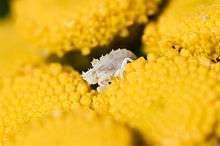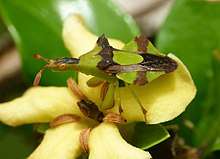Phymatinae
Insects in the subfamily Phymatinae are commonly called ambush bugs after their habit of lying in wait for prey, relying on their superb camouflage. Armed with raptorial forelegs, ambush bugs routinely capture prey ten or more times their own size. They form a subgroup within the assassin bugs.
| Phymatinae | |
|---|---|
| Phymata sp. | |
| Scientific classification | |
| Kingdom: | Animalia |
| Phylum: | Arthropoda |
| Class: | Insecta |
| Order: | Hemiptera |
| Family: | Reduviidae |
| Subfamily: | Phymatinae Laporte, 1832 |
| Tribes | |
| |
Description


Phymatinae are 5–12 mm (0.20–0.47 in) long. In Phymata, the scutellum is triangular and shorter than the pronotum. In Macrocephalus, the scutellum is narrow and rounded and extends to the tip of the abdomen.[1]
Phymatinae normally have a large fore femur and clubbed antennae. The forewing membranes sometimes lack distinct cells.[2]
The antennae have four segments. There are two ocelli. The beak has three segments. The tarsi also have three segments. The rear half of the abdomen expands beyond the edges of the wings.[3]
Etymology
The name Phymatinae is derived from the Greek phymata meaning "swollen", which presumably refers to the enlarged abdomen and femora.[4]
Taxonomy
The subfamily Phymatinae was often given family-level status and this classification is still used in some textbooks. Based on cladistic analyses, however, ambush bugs (Phymatinae) are part of the family Reduviidae (assassin bugs).[5][6] They are a sister group of the Holoptilinae.[7]
The Phymatinae include the following genera:[8][9]

- Amblythyreus
- Lophoscutus Kormilev, 1951
- Macrocephalus Swederus, 1787
- Phymata Latreille, 1802
- Themonocoris
- Glossopelta
- Carcinocoris
- Chelocoris
- Microtomus
- Neocentrocnemis
- Ptilocnemus
- Agdistocoris
- Agreuocoris
- Bakerinia
- Cnizocoris
- Diurocoris
- Eurymnus
- Extraneza
- Goellneriana
- Hoberlandtiana
- Kormilevida
- Metagreuocoris
- Narina
- Oxythyreus
- Parabotha
- Paragreuocoris
References
- Ross H. Arnett (2000). American insects: a handbook of the insects of America north of Mexico. CRC Press. ISBN 978-0-8493-0212-1. Retrieved 31 March 2011.
- "Phymatidae". University of California, Riverside. Archived from the original on 2009-01-31.
- "Phymatid". University of Florida. Archived from the original on 2009-07-27.
- Phyma at dictionary.com.
- Handlirsch, A.; Austria) (1897). "Monographie der Phymatiden". Annalen des K.K. Naturhistorischen Hofmuseums. 12: 127–230.
- Christiane Weirauch & James B. Munro (2009). "Molecular phylogeny of the assassin bugs (Hemiptera: Reduviidae), based on mitochondrial and nuclear ribosomal genes". Molecular Phylogenetics and Evolution. 53 (1): 287–299. doi:10.1016/j.ympev.2009.05.039. PMID 19531379.
- Weirauch, Christiane; Forero, Dimitri; Jacobs, Dawid H. (2011). "On the evolution of raptorial legs - an insect example (Hemiptera: Reduviidae: Phymatinae)". Cladistics. 27 (2): 138–149. doi:10.1111/j.1096-0031.2010.00325.x.
- "Phymatinae". Integrated Taxonomic Information System.
- Masonick, Paul; Michael, Amy; Frankenberg, Sarah; Rabitsch, Wolfgang; Weirauch, Christiane (2017). "Molecular phylogenetics and biogeography of the ambush bugs (Hemiptera: Reduviidae: Phymatinae)". Molecular Phylogenetics and Evolution. 114: 225–233. doi:10.1016/j.ympev.2017.06.010. PMID 28634150.
| Wikimedia Commons has media related to Phymatinae. |
| Wikispecies has information related to Phymatinae |